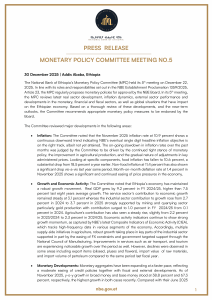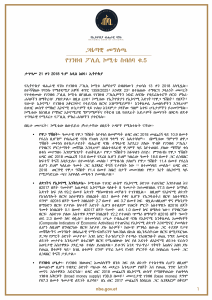The Board of National Bank of Ethiopia (NBE) has issued five revised Directives governing banking business in line with its mandates to uphold financial sector soundness and stability. The directives have been revised to align with international best practices such as the Basel Core Principles for Banking Supervision and to accommodate new developments in the sector, thereby building the foundation for strong and inclusive growth.
Safeguarding financial stability is a core function of NBE: a sound and stable financial system help channel resources to their most productive uses. It is critical for public savings to be mobilized, protected, and deployed safely for the purposes of economy-wide lending, investment, and growth. To this end, NBE is announcing major changes to its regulatory systems in line with global standards and in response to the development of the domestic banking industry – as incorporated in its three years Strategic Plan.
The revised regulatory standards fall into two broad groups: the first one – the Large Exposure Limit Directive, Related Party Exposure Directive and Asset Classification and Provisioning Directive – is aimed at reducing vulnerabilities and improving risk management frameworks. The second group of Directives – Fit and Proper Test Directive, and Corporate Governance Directive – enhance the effectiveness of Banks’ oversight and management functions through best practice corporate governance principles.
The key reforms introduced by the five revised Directives include:
I. Large Exposures to Counterparty or Group of Connected Counterparties Directive: aims to limit the losses that could be incurred by a Bank because of a single party’s (including a group of connected parties) failure to honor obligations and to ensure banks have adequate policies and processes to control or mitigate concentrations of risk on a timely basis. The Directive limits the aggregate sum of all large exposures directly held by a bank to a counterparty or group of connected counterparties to 25% of the bank’s total capital, in line with Basel Standards. The Directive also stipulates that lending to a group of connected (through control or economic interdependencies) parties is to be treated as lending to a single borrower. It also requires banks to put in place policies and procedures governing large exposure and risk concentration.
II. Exposure to Related Party Directive: aims to minimize abuse, conflict of interest and extraction of private benefit from banks by related parties and ensures that banks’ transactions with related parties are adequately monitored and are made on arm’s length basis. Related parties are persons connected with the bank either through control and/or employment. The Directive limits the sum of all exposures directly or indirectly held by a bank to any single related party at any time to 15% of its total capital and the aggregate sum of exposures to all related parties combined to 35% of the total capital. The Directive also forbids that a bank conducts any transactions with a related party on preferential terms compared to conditions normally applied to unrelated parties.
III. Asset Classification and Provisioning Directive: aims for loans or advances to be regularly reviewed and classified in a manner consistent with accepted principles of international accounting and regulatory standards to ensure prudent risk governance of banks. The Directive requires banks to report all restructured loans of material size above 5% of their capital to the NBE and tightens the conditions for how banks treat restructured loans and non-performing loans. This includes:
All Non-Performing Loans must be placed under non-accrual status irrespective of the type of collateral provided to secure the loan as per Basel principles.
In case of multiple loans to a client, if one of the loans is non-performing and accounts for 20% or more of the bank’s total exposure to the customer, all loans to this customer must automatically be reclassified as non-performing.
The Directive introduces an “unlikely to pay” class of loans to allow for circumstances that makes loans unlikely to be repaid irrespective of the number of past dues to be treated as non-performing loans
The Directive restricts the maximum allowed restructuring iteration for a Bank to three for short- and medium-term loans (from five previously) and to four for long-term loans (from six previously) to prevent ever-greening of loans.
The Directive has been aligned with International Financial Reporting Standards (IFRS) in regard to determination of Nonperforming Loans and provisioning requirements. Banks are now required to provide provision for their on-balance sheet as well as off-balance sheet exposures.
IV. Requirements for Persons with Significant Influence in a Bank Directive: aims to ensure stability and long-term institutional success of the banking sector; maintain public confidence on the integrity of the financial system through having fit and appropriate owners, directors and managers, and to continuously enhance the effectiveness and soundness of corporate governance in banks. Among the reforms introduced are tightened requirements for boards of directors and senior management of banks, including, limited number of directorships and higher qualifications and relevant experience.
V. Bank Corporate Governance Directive: aims to introduce stronger governance measures to contribute to balanced risk-taking and enhancing business prudence and corporate accountability with the ultimate objective of realizing long-term shareholder value, as well as customer and other stakeholder interests. To this end, the revised Directive introduces the requirement of independent persons to be Included as members of board of directors, makes changes to board election procedures and the functions of board nomination and election committees. To ensure inclusion and diversity, the Directive also requires that a bank’s board now includes at least two female directors; a maximum of two bank employees may also sit on the board.



